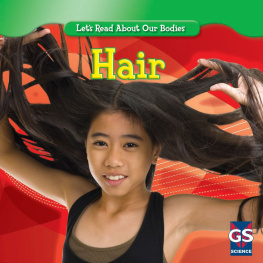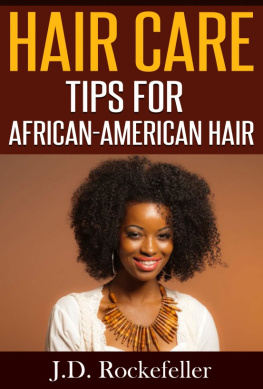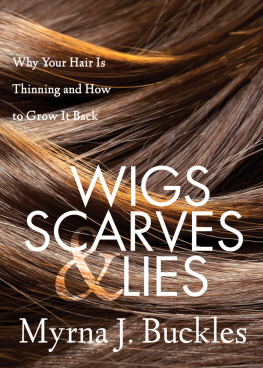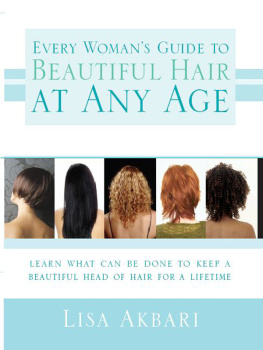The Hair Bible


ATRIA BOOKS
1230 Avenue of the Americas
New York, NY 10020
www.SimonandSchuster.com
This book is meant to educate and inform and should not be used as an alternative to appropriate medical care. For this reason, check the safety and efficacy of all medications and procedures with your doctor before using them.
Copyright 2003 by LifeTime Media, Inc.
All rights reserved, including the right of reproduction in whole or in part in any form.
A LifeTime Media Production LifeTime Media, Inc. 352 Seventh Ave., 15th Floor NY, NY 10001
President: Jacqueline Varoli
Editorial Director: Karen Kelly
Designed by Elissa Stein
Illustrations by Linda Anne Crank
Photos: Getty Images
ISBN 0-7434-4260-1
ISBN 13 978-0-7434-4260-2
eISBN 13 978-0-7434-4925-0
First Atria Books hardcover printing April 2003
10 9 8 7 6 5 4 3 2 1
ATRIA BOOKS and colophon are registered trademarks of Simon & Schuster, Inc.
For information regarding special discounts for bulk purchases, please contact Simon & Schuster Special Sales at 1-800-456-6798 or business@simonandschuster.com
Printed in the U.S.A.
Contents
Introduction
Learning to live with or without your hair is a huge part of life. When we are born, we have very little hair, and soon it begins to grow into place. One of the first things we need to learn, in addition to how to walk, talk, eat, and speak is how to deal with our hair. Everyones hair is different, so its important for each of us to know the specifics of how our hair fits into our lifestyle.
We must become familiar with our hair type and learn how to care for itwhen to shampoo it and when to let it go another day, how much conditioner to use and how long to leave it on, which brush to use and exactly when to start styling it.
My sisters inherited my moms thick hair and they both have long, wavy manes. Always my fathers daughter, I had to settle for pin-straight limp locks. The sibling rivalry started at an early age when we each wanted what the other had and it continues to thrive.
As we grow older, our hair grows too. Throughout our childhood, we choose the most decadent barrettes, ribbons, and bows and beg our moms to fasten them at the ends of pigtails and braids. Then we watch them spend hours on end trying to get the knots out after a long day at play. I will never forget that faithful bottle of No More Tangles sitting at the edge of the bathtub, ready and waiting to diligently go to work. For special occasions, my mom would set my stick-straight brunette locks in rollers and leave them in place overnight, only to unroll them the next morning and see the curls droop minutes later. Years of tap dancing lessons provided plenty of opportunities for carefully coifed dos that would take hours to undo at the end of each performance. Wed always find tiny flecks of silver glitter from our costumes strewn throughout our follicles.
Through it all, I was grateful that my generation did not have to endure what our mothers and grandmothers did. My mom, who grew up in the pre-blow-dryer era of the 1950s, remembers sitting under a hair cap with a hose attached to dry her hair. She wrapped her hair with toilet paper to straighten it and slept on hard curlers since softer versions were not yet available. In the 1960s her friends used falls, a sort of wig that let them wear their hair Hollywood style. My dad didnt approve of Mom sporting someone elses hair, so she grew her hair long, then cut it off and created her own fall.
My great-aunt tells stories of doing both her moms hair and her daughters. Her mom, my great-grandmother, had long silver locks, and my aunt used to set them in pin curls every night. Years later, before the flat iron was born, she slaved over an iron and ironing board trying to straighten her daughters wildly curly mane.
So my life in relation to my hair seemed comparatively easierI just had to get through it.
As the oldest of three daughters, whom my mom loved to dress alike, I was known as one of the Bressler sisters. Time and again our parents friends and distant relatives failed to grasp the concept that we each had our very own individual first names. Things got worse when our mom started taking us to the same hair shop to get our haircuts. A famous photo that used to sit on our baby grand piano features all three of us and my mom with similar dos.
Class pictures were no fun either. I will never forget the night before my fourth-grade photo session when my mom took us to the local barber shop. My boyish pixie cut couldnt have happened at a worse time, and Ill always have the snapshot to remember it by.
Dorothy Hamill made the bob famous during my year in fifth grade, and of course I had to try it before deciding to let my hair grow to at least shoulder length. By the sixth grade, Barbra Streisand brought back the perm. The most popular girls in class, who probably had their own personal hairdressers, were the first to test-drive the new chemical concoctions and looked ultra-glam. But just my luck, I came out looking as if Id stuck my finger in an electric socket. And there was no hiding it! By the end of first period, news of my afro was already circulating, and kids were stopping by my locker between periods to see the damage for themselves. In seventh grade, there wasnt one male classmate who didnt have the poster of Farrah Fawcett in her red bathing suit hanging above his bed, spotlightingamong other thingsher golden blonde feathered-back mane.
Thank goodness for high school! (We would finally be allowed to express our individuality and wear our hair the way we wanted.) During my first semester, however, nothing prepared me for being chosen as a volunteer in the annual assembly for energy conservation. Little did I know that public humiliation was only seconds away as I was pulled from the audience, walked onto the stage in front of half the school, and gently placed my hand on the static electricity machine, only to have all the hairs on my head stand on end! The laughter was deafening.
During the next few years, my hair would undergo a series of extreme measures. Four years on the swim team (hundreds of laps a week in a chlorinated pool) were starting to take its toll. My hair turned tints of yellow, then green. My sisters and I tried every shampoo and conditioner under the sun. I remember being amazed at the fact that Body on Tap contained a healthy dose of beer. We turned to Wella Balsam and Pert to cleanse away our dirt and grime. We related to the Breck Girls as they bounced their beautiful locks across the TV screen. And we told two friends about the miracle of Faberge, and they told two friends, and so on and so on and so on. In the summers, we soaked in Sun-In and, when our mom put her foot down, we used real lemons instead. We fed our hair fattening egg yolks, vinegar, and mayonnaise because they were supposed to give us the beautiful, shiny, healthy hair that we dreamed of.
College was another era, and we couldnt wait to embrace it. Neither could our hair. Still eager to stand out in the collegiate crowd, I dragged my mom to the hair salon on a school break and made her watch as I let the colorist add what I thought would be subtle streaks. About twenty minutes into the process, my mom nervously screamed, Thats enough! and I was whisked out of the salon. I didnt know the damage that had been done until a year later when the pledges in my sorority had to learn the names of all the founding sisters, of which I was one. One girl thanked me for making myself easy to remember. Youre the girl with the streak down the back of her head! she said.
Next page








